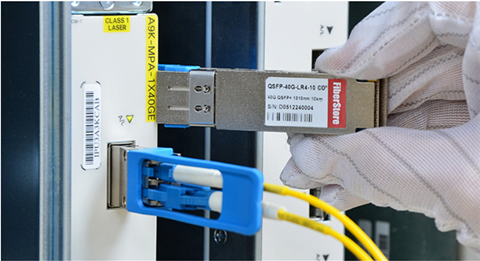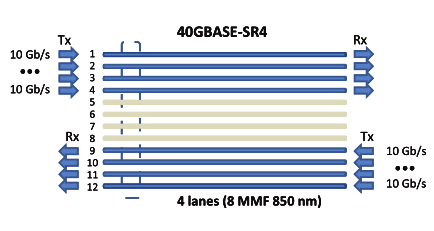The rapid growth in storage and computing services is driving an expansion in both the physical size and overall computing power of the modern data center. This high-speed data interconnects linking the individual optical elements within a data center are typically comprised of fiber optical solutions (multimode or single-mode). Limited to short linking distances, multimode fiber interconnects are most often used to provide server-to-server or server-to-network switch connections within the same rack or chassis. Inter-rack and inter-chassis connections, which usually require greater reach and higher bandwidth, demand a single-mode fiber optic solution and are enabled by WDM-based parallel optical transceivers. Data rates of 10 Gbqs and higher are now commonplace in the modern data center, here is what you should know about data center cabling solution.
Multimode vs. Single-mode Fiber Solution
Data rates and link distance are the two important parameters typically characterized for fiber optic interconnect. When considering both of these requirements for a given application, link distance plays a key role in determining what type of optical module or fiber infrastructure to deploy. Applications with individual channel rates of 10 Gbqs requiring link distances of less than 300 m have traditionally been serviced by Vertical Cavity Surface Emitting Laser (VCSEL) based solutions operating over multimode fiber. These applications are often referred to as “Short Reach” by industry standards. For example, the 40GBASE-SR4 of the IEEE 802.3ba physical layer standard defines a 4-lane parallel optical interconnect for operation up to 100 meters in length over OM3 multimode fiber. Take Cisco QSFP-40G-SR4 as an example, this Cisco 40GBASE-SR4 transceiver (see in Figure 1) can support a link distance of up to 150m. Under this standard, 40Gbqs switch-to-switch uplinks can be realized using QSFP+ optical transceivers and MTP connector-based parallel multimode fiber cables. Besides 40GBASE-SR optics, 40G QSFP+ cables (AOC or DAC) are also a practical 40G solution. QSFP+ to 4SFP+ Passive Copper Cable (e.g.HP JG330A) provides a cost-effective solution for 40G short-reach interconnect application.

So called “Long Reach” applications typically involve link distances on the order of kilometers, and rely on more costly Fabry-Perot (FP) or Distributed Feedback (DFB) laser-based solutions running over single-mode fiber. While single-mode solutions provide a greater maximum link distance, they typically do so with higher power dissipation, and as mentioned previously, a higher module cost. Historically, multimode solutions could comfortably satisfy the switch-to-switch interconnect demand within the data center since link distances greater than 300 m were rarely, if ever, required. Now, with the rise of the Mega Data Center comes the realization that maximum switch-to-switch spacing may actually exceed 300 meters, and that a longer reach multimode solution is needed.
Short Reach With Multimode Fiber
Multimode fiber (MMF) has become widely used for up to 10Gbqs. It provides the lowest cost and lowest power connectivity with trouble-free installation for the data center designers. But MMF is running out of bandwidth at 10G, so parallel optics at 40G uses 4x10G channels and uses 10x10G channels for 100G, which has a great impact on the fiber count needed to support equipment. MM links at 10G are also power limited due to the bandwidth penalty caused by the limited modal bandwidth of the multimode fiber. MM links may only have ~<2dB loss budgets meaning that the data center cable cannot have many interconnections especially with the MPO multifiber array connectors which are inherently higher loss than single fiber ceramic-ferrule connectors like LCs and SCs.
Thus parallel optics assemblies use the MPO connector which has 12 or 24 fibers per connector. The limitation of parallel optics with MPO connections includes the masses of fibers required and the fewer interconnects allowable because of the typically higher loss of the MPO connector. Here is an example of a 40G and 100G solutions on multimode fiber. 40G uses a 12 fiber MPO with 4 channels each at 10G for transmit and receive on separate fibers, so there are 4 transmit and 4 receive fibers. Since the MPO connector has 12 fibers, the center 4 are unused just as shown in Figure 2.

100G uses 10 channels each at 10G for transmit and receive on separate fibers on a 24 pin connector, so there are 10 transmit and 10 receive fibers. Since the MPO connector has 12 fibers in each row, the center 4 are unused. There is another version of 100G being developed that uses 4 X 25g channels which will have shorter reach. This design should use a connection scheme like 40G on a 12 fiber connector.
To sum up, multimode transceivers use inexpensive 850nm VCSELs so the transceivers are cheaper than singlemode but the fiber optic cable plant uses many multimode fibers so the cable plant is more expensive.
Longer Reach with Single-mode Fiber
Single-mode fiber are more preferable for unlimited bandwidth and distance capability when used in data centers. Unlike the parallel 10G channels used with MM fiber, single-mode uses wavelength division multiplexing (WDM) to transmit multiple channels over one fiber at different wavelengths. Thus 40G uses 4X10G wavelengths and 100G is achieved using 4x25G wavelengths. CWDM transceivers cost more than parallel MM transceivers at the current time, but the cabling cost is much lower and expected higher quantity usage will drive costs down. Look what 100million users did for the lasers and CWDM used in fiber to the home (FTTH.)
Conclusion
The rapid expansion of telecommunications networks, and data services, measured either by data volume or bandwidth, means fiber optic technology will be a significant part of future systems. Compared to multimode cabling solutions, single-mode technology is more flexible, lower power and higher bandwidth but more costly. Fiberstore offers a broad portfolio of products with a history of market leadership and innovation. These fiber optic solutions are suited for applications within the data center, as well as for short or longer distances bridging one data center to another. These products span 10G Ethernet, 40G Ethernet and 100G Ethernet over reaches from 2-10km to 80km in form factors such as SFP+, QSFP+, QSFP28, CFP/CFP2/CFP4, X2 and XFP.
评论
发表评论